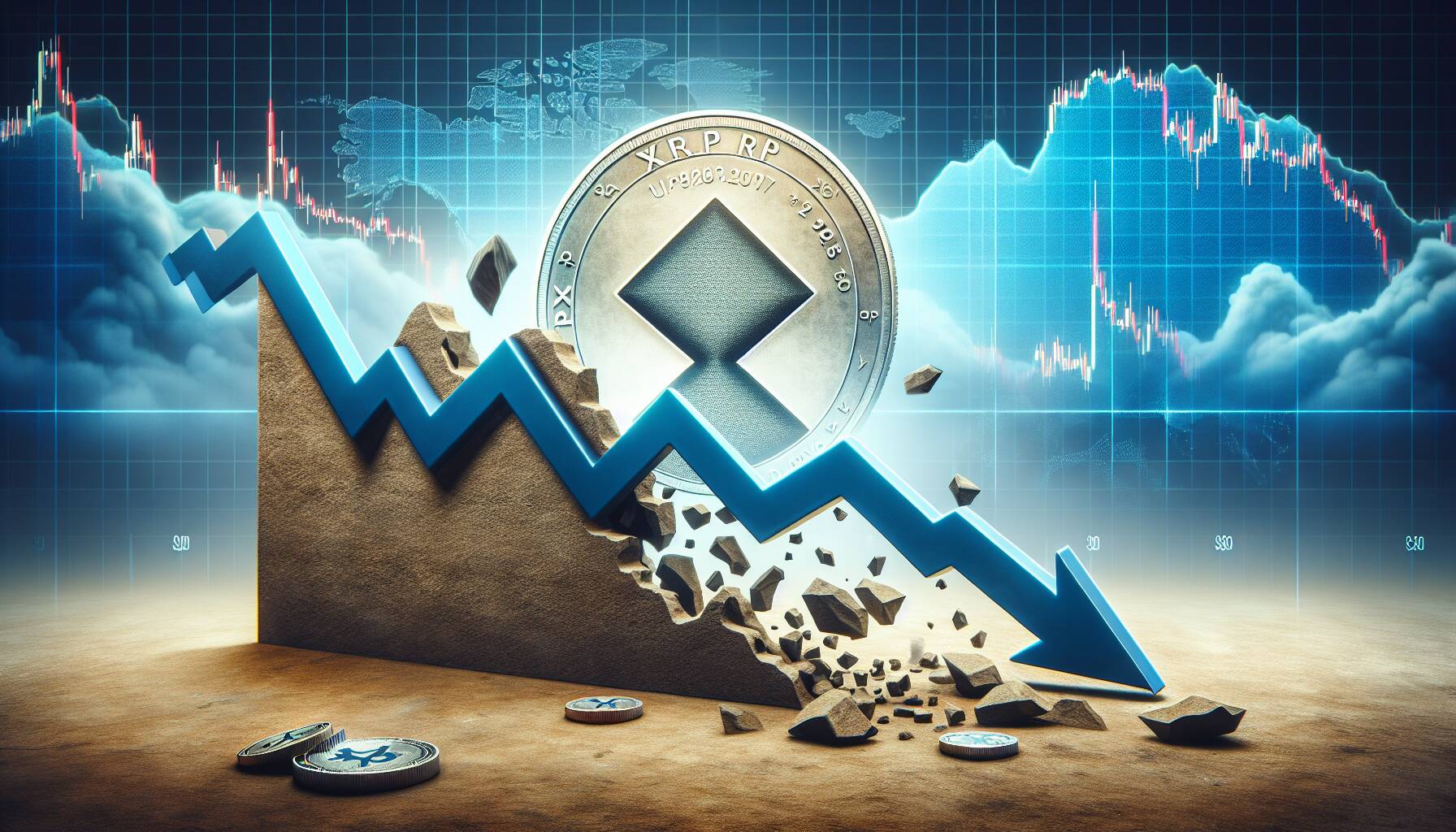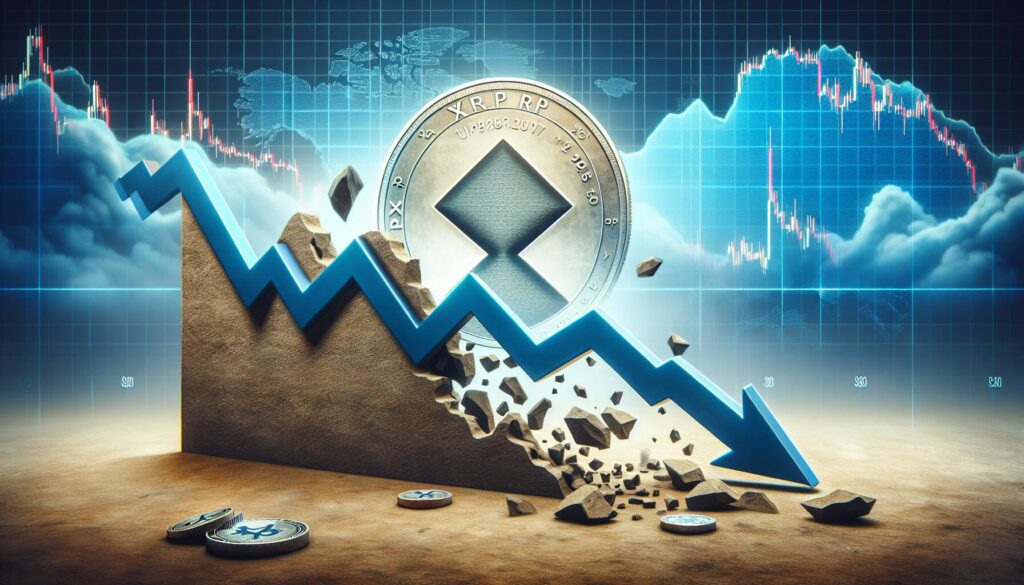In the ever-dynamic world of cryptocurrency, XRP, primarily known for its payment-focused capabilities, is currently facing some troubling times. After a period of cautious optimism, the price trend appears to be shifting dramatically, with analysts observing a technical pattern known as a “rising wedge” breakdown.
The concept of a rising wedge involves two trendlines that converge, creating a pattern that suggests a potential weakening of upward momentum. Recently, XRP demonstrated a significant shift as it dipped below the lower trendline of this wedge, signaling a potential move toward a bearish market trend. This shift signifies that the attempted price recovery from the lows experienced in early April, where XRP hovered around $1.60, may be losing steam and paving the way for sellers to take charge once more.
This bearish sentiment is further supported by XRP’s position relative to the Ichimoku Cloud, a well-respected momentum indicator in technical analysis. Having fallen below this cloud on the hourly chart, the outlook seems increasingly pessimistic for XRP’s future price direction.
Currently, market watchers are keenly eyeing the price action. The previous day’s high, around $2.18, remains a critical point for bulls seeking to overturn this negative trend. If they can push prices back above this threshold, it may help regain some confidence and possibly change the emerging narrative. For now, XRP’s trajectory offers a stark reminder of the volatility inherent in the cryptocurrency sector, underscoring the need for careful observation and analysis in an ever-evolving market landscape.

Key Insights on XRP’s Current Market Situation
The recent analysis of XRP’s price action reveals several critical factors that could impact both traders and investors in the cryptocurrency market. Here are the main points to consider:
- Rising Wedge Breakdown: XRP has formed a rising wedge pattern, characterized by converging trendlines connecting higher lows and higher highs. This suggests a weakening upward momentum.
- Bearish Trend Signal: A breakdown below the lower trendline serves as a significant indicator of a potential shift to a bearish trend, which could lead to further declines in XRP’s price.
- Price Movement: XRP’s recent dip below the rising wedge pattern signifies a loss of upward momentum, indicating that sellers are regaining control of the market.
- Historical Support Level: The breakdown implies that XRP could retest the $1.60 support level, which was a recent low and a critical point for potential buyers.
- Ichimoku Cloud Indicator: XRP’s drop below the Ichimoku Cloud on the hourly chart has further solidified the bearish outlook, suggesting a prolonged period of downward price movement.
- Resistance Level for Bullish Reversal: For a bullish reversal to occur, XRP must surpass Tuesday’s high of $2.18 to invalidate the current bearish trend.
Understanding these technical indicators is essential for traders, as they help in making informed decisions about buying or selling XRP, potentially affecting their financial outcomes.
By closely monitoring these factors, readers can better navigate the volatile landscape of cryptocurrency investments and make more strategic choices in their trading activities.
Assessing XRP’s Current Market Dynamics: Opportunities and Challenges
XRP, the payments-focused cryptocurrency, is currently navigating a challenging landscape, with its price action exemplifying a “rising wedge” breakdown. This bearish setup has caught the attention of market analysts, who highlight the potential shift in market sentiment. In comparison to other cryptocurrencies, XRP’s immediate prospects look particularly disheartening, especially with analysts predicting a possible fall back to previous support levels around $1.60.
One notable competitive advantage that XRP boasts is its positioning in the payments sector, where it has carved out a niche among financial institutions seeking to utilize blockchain technology for faster and cheaper transactions. Compared to competitors, XRP often emphasizes its real-world utility, which can attract institutional investors who prioritize functionality over mere speculation. However, this utility alone may not suffice if the negative technical indicators continue to signal bearish trends; the recent dip below key support levels could deter new investments at a time when many investors are looking for stability.
On the downside, the recent performance of XRP also showcases significant vulnerabilities. The breakdown from the rising wedge not only threatens to push the price down further but also raises concerns about the cryptocurrency’s long-term viability. Investors could face difficulties as the price remains below critical momentum indicators like the Ichimoku Cloud. Moreover, the psychological impact of failing to break resistance at $2.18 further reinforces a negative perception that can deter bullish sentiment among potential traders and existing holders alike.
These dynamics may particularly benefit day traders and opportunistic investors who thrive in volatile environments. For those adept at short-term trading strategies, XRP’s current situation presents opportunities to capitalize on price fluctuations. Conversely, long-term investors might experience significant challenges, as the prevailing bearish sentiment and potential dips could erode their holdings. Understanding these nuances is critical, as XRP navigates a sea of uncertainty against its competitors in the expansive crypto market.

















